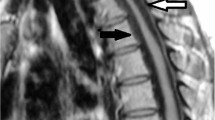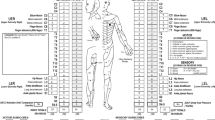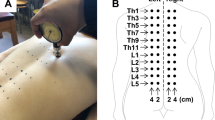Abstract
Study design: Case report of a rare form of hypertrophy of the thoracic posterior longitudinal ligament (HPLL), causing paraparesis.
Objective: To describe this very rare pathological condition in the thoracic spine and the results of surgical intervention.
Setting: A department of orthopaedic surgery in Japan.
Methods: A 61-year-old man presented with acute paraparesis associated with HPLL in the thoracic region. A radiographic and pathological review of the case was conducted. Anterior decompression was performed, and he was followed for 3 years after the operation.
Results: Pathologic examination of the surgical specimen revealed proliferation of fibrocartilage and calcification. The patient's paraparesis ameliorated after the operation.
Conclusion: For this case of myelopathy due to HPLL in the thoracic spine, urgent decompression gave excellent results. Clinical awareness of HPLL may aid correct diagnosis and prompt therapy.
Similar content being viewed by others
Log in or create a free account to read this content
Gain free access to this article, as well as selected content from this journal and more on nature.com
or
References
Matsumoto T et al. Lumbar canal stenosis caused by hypertrophy of the posterior longitudinal ligament: case report. Spine 2001; 15: E576–E579.
Hase H et al. Severe cervical myelopathy due to diffuse hypertrophy of the cervical posterior longitudinal ligament. Spine 1992; 17: 1417–1421.
Mizuno J, Nakagawa H & Hashizume Y . Analysis of hypertrophy of the posterior longitudinal ligament of the cervical spine, on the basis of clinical and experimental studies. Neurosurgery 2001; 49(5): 1091–1098.
Toguchi A et al. An operative case of hypertrophy of the posterior longitudinal ligament in thoracic spine. East Jpn J Clin Orthop 1991; 3: 524–528 (in Japanese).
Nakamitsu K et al. Thoracic myelopathy caused by hypertrophy of thoracic posterior longitudinal ligament: A case report. Clin Orthop Surg 1990; 25: 1087–1090 (in Japanese).
Yamazaki A et al. Magnetic resonance imaging and histologic study of hypertrophic cervical posterior longitudinal ligament. Spine 1991; 16: 1262–1266.
Kamikozuru M & Yamaura I . Hypertrophy of the cervical posterior longitudinal ligament (a provisional name) causing myelopathy: A case report. Clin Orthop Surg 1975; 10: 1097 (in Japanese).
Epstein NE . Ossification of the posterior longitudinal ligamentin evolution in 12 patients. Spine 1994; 19: 673–681.
Kondo S et al. Hypertrophy of the posterior longitudinal ligament is a prodromal condition to ossification. Spine 2001; 26: 110–114.
Ono K et al. Pathology of ossification of the posterior longitudinal ligament and ligamentum flavum. Clin Orthop 1999; 359: 18–26.
Acknowledgements
We thank Prof. T Inuzuka of Dept. of Geriatrics and Neurology, Gifu University, and Drs T Nishimoto, T Hiramatsu, and N Suzuki of Yoro Central Hospital.
Author information
Authors and Affiliations
Rights and permissions
About this article
Cite this article
Nozawa, S., Shimizu, K., Miyamoto, K. et al. Sudden onset of paraparesis caused by hypertrophy of the thoracic posterior longitudinal ligament. Spinal Cord 41, 53–55 (2003). https://doi.org/10.1038/sj.sc.3101396
Published:
Issue date:
DOI: https://doi.org/10.1038/sj.sc.3101396
Keywords
This article is cited by
-
Hypertrophied posterior longitudinal ligament and ligamentum flavum causing myelopathy: a case report and literature review
Spinal Cord Series and Cases (2023)
-
Hypertrophy of the posterior longitudinal ligament in the thoracic spine
Spinal Cord (2006)



